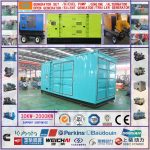Introduction
Diesel generators are an essential source of backup power for a wide range of applications, from hospitals and data centers to construction sites and remote locations. While these generators offer reliable power supply during outages or in off-grid settings, they also produce noise that can cause disturbances to nearby residents or workers. In response to concerns about noise pollution, governments and regulatory bodies around the world have implemented strict regulations to limit the noise emissions from diesel generators. This article will explore the impact of noise regulations on diesel generators, the factors influencing noise levels, and strategies for ensuring compliance while minimizing environmental impact.
Understanding Diesel Generator Noise
Noise generated by diesel generators is primarily a result of the combustion process within the engine and the mechanical operation of the generator components. The sound produced by a generator is measured in decibels (dB), with higher dB levels indicating louder noise. The noise level of a diesel generator can vary depending on several factors, including the size and power output of the generator, the type and condition of the engine, the design of the exhaust system, and the distance from the source of the noise.
In general, larger diesel generators with higher power outputs tend to produce more noise than smaller generators. The type and condition of the engine also play a significant role in determining noise levels, with older or poorly maintained engines often generating more noise than newer, well-maintained engines. The design of the exhaust system can impact noise emissions by controlling the flow of exhaust gases and minimizing the escape of noise. Additionally, the distance from the generator can affect the perceived noise level, with noise decreasing as the distance from the source increases.
Impact of Noise Regulations on Diesel Generators

Noise regulations for diesel generators are typically set by government agencies or local authorities to protect public health and safety, as well as to minimize disturbances to communities and the environment. These regulations establish maximum allowable noise levels for different types of generators and specify the methods for measuring and monitoring noise emissions. Failure to comply with noise regulations can result in fines, penalties, or restrictions on the operation of diesel generators.
The enforcement of noise regulations can have significant implications for businesses, organizations, and individuals that rely on diesel generators for backup power or primary power supply. Non-compliance with noise regulations can lead to legal consequences, damage to reputation, and disruptions to operations. As a result, it is essential for generator owners and operators to understand the noise regulations that apply to their specific situation and take steps to ensure compliance.
Factors Influencing Noise Levels in Diesel Generators
Several factors can influence the noise levels produced by diesel generators, including:
1. Generator Size and Power Output: Larger generators with higher power outputs tend to produce more noise than smaller generators.
2. Engine Type and Condition: The type and condition of the engine can affect noise emissions, with older or poorly maintained engines typically generating more noise.
3. Exhaust System Design: The design of the exhaust system plays a crucial role in controlling noise emissions by directing exhaust gases and minimizing noise escape.
4. https://www.lkpowerplant.com/400kw/ from the Generator: The perceived noise level decreases as the distance from the generator increases, with noise levels typically lower at greater distances.
Strategies for Ensuring Compliance and Minimizing Environmental Impact
To ensure compliance with noise regulations and minimize the environmental impact of diesel generators, generator owners and operators can implement the following strategies:
1. Regular Maintenance and Inspection: Regular maintenance and inspection of diesel generators can help identify and address issues that may contribute to increased noise levels, such as worn-out components or loose connections.
2. Engine Upgrades and Retrofits: Upgrading older engines or retrofitting existing generators with noise-reducing components can help reduce noise emissions and improve overall performance.
3. Soundproofing and Enclosures: Installing soundproofing materials around the generator or using soundproof enclosures can help contain noise emissions and minimize disturbances to nearby residents or workers.
4. Location and Placement: Selecting an appropriate location for the generator and ensuring proper placement can help reduce noise propagation and minimize the impact on surrounding areas.
5. Monitoring and Compliance Reporting: Regular monitoring of noise emissions and compliance reporting can help generator owners and operators track noise levels, identify trends, and demonstrate compliance with regulations.
Conclusion
Diesel generators play a crucial role in providing backup power and reliable electricity supply in various applications. However, the noise generated by diesel generators can pose challenges in terms of compliance with noise regulations and environmental impact. By understanding the factors influencing noise levels in diesel generators and implementing strategies to ensure compliance and minimize noise emissions, generator owners and operators can mitigate the impact of noise pollution and contribute to a more sustainable and responsible use of diesel generators. Compliance with noise regulations is essential to protect public health and safety, preserve the quality of life in communities, and uphold environmental standards. By taking proactive measures to address noise emissions, generator owners and operators can demonstrate their commitment to responsible operation and contribute to a cleaner and quieter environment.
